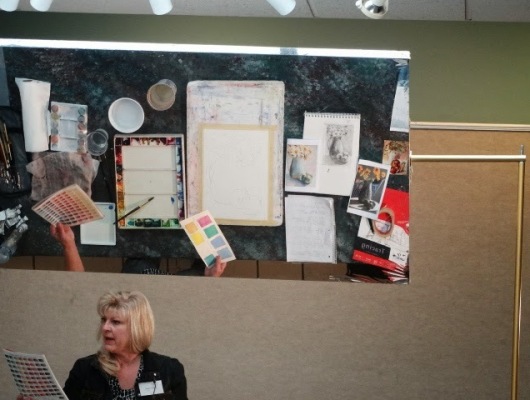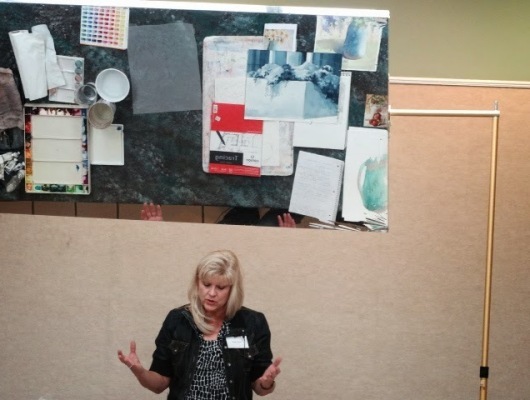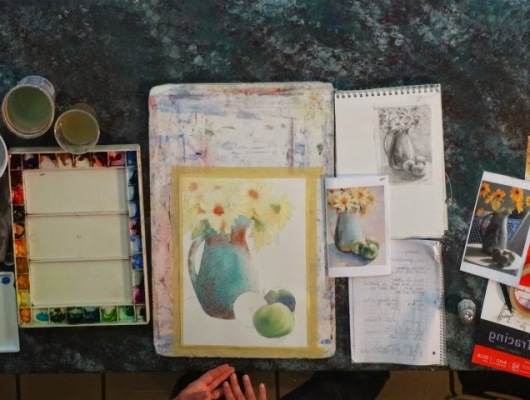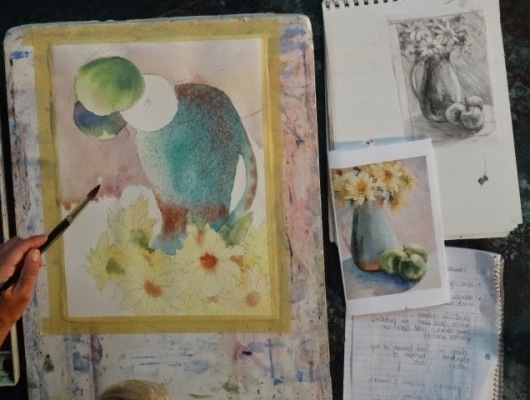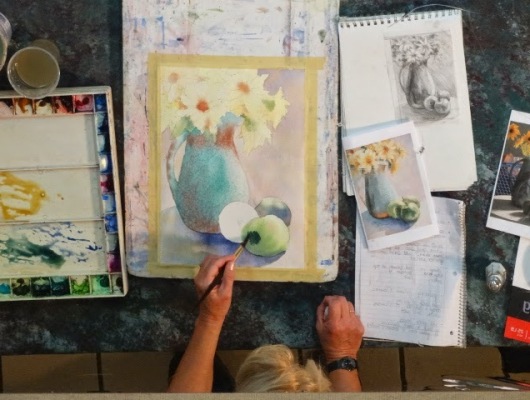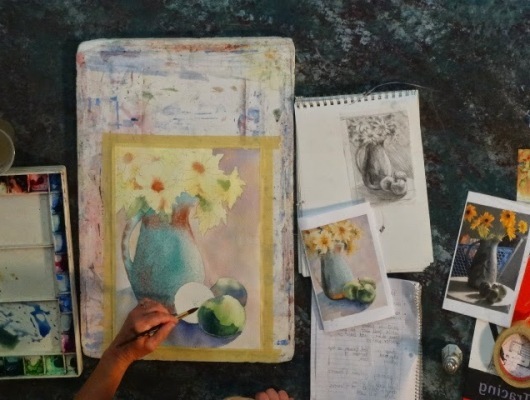OCTOBER 2014 PROGRAM - SUE GROGAN
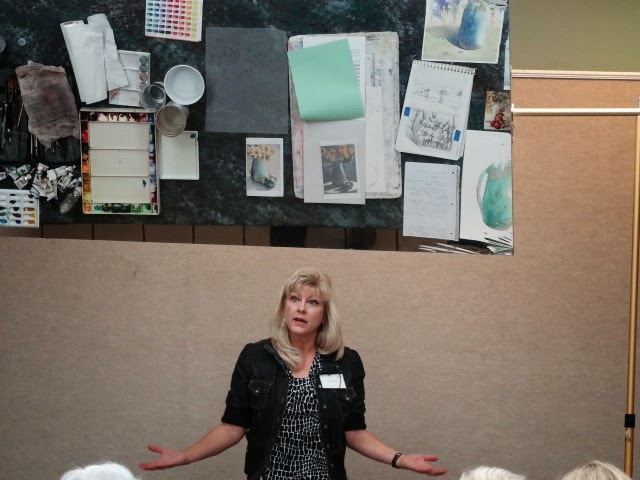
Joan O’Leary introduced our own Susan Grogan to be our Presenter for October. She told us that Watercolor Painting became Susan’s “favorite” when she was in high school. Although she has worked in many other mediums, especially while attending technical college for Art, during her work as a fashion illustrator, and other classes and workshops, Watercolor remains her favorite. Susan has her work in a number of places around the Greater Cincinnati area, including One Main Galley in Milford, the Queen City Art Club and the Cincinnati Nature Center. She also teaches classes – at Hobby Lobby in Eastgate, and Miami Township Senior Center in Milford. (From personal experience – all her students love her)
Susan talked about her “process”, that is, she does a small “thumbnail” sketch to make decisions about the composition – so that the eye will travel around the finished painting. Then, she does a “value” study, to make decisions about where the light source will be, and which parts of the painting will be light, and which will be dark. And, even though her students love to “hate” doing these thumbnails and studies, Susan believes that a much better painting is the result of completing them. An easy way to do the value study is to put a piece of tracing paper (a very transparent one is Canson) over your thumbnail and color in the lights and darks. Then, you can place your tracing paper on top of a white piece of paper so that it is very easy to see. Have this, and your thumbnail handy nearby as you paint, for reference. Lately, Susan has been painting on 140 lb. coldpress, Arches Rough paper as it has more body.
If one looks closely at pottery, you notice it has a glaze, with runs, and granulated colors. In order to replicate this finish in a painting, Susan likes the rough paper, uses salt and sometimes, just splattered water. She first used a kneaded eraser to take off some of the pencil marks, especially if using yellow colors, because you want to let the white of the paper show through to make the yellow bright, not heavy paint to make it bright. She does not have many expensive brushes, but just replaces hers when she wears out the point (as she prefers round brushes for most things). Granulated colors (usually opaque) are good for pottery as the pigments tend to sit on top of the paper. She uses mostly Di Vinci paints, with some Daniel Smith or others. She tries not to use miskit, but paints around the places she wants to leave white, etc., or uses more water, or “lifts out” afterwards.
Susan believes in using “loaded” brushes, much water and paint, dipping in often, trying not to “drag” the paint around. Most of the time she paints a light wash, drops in a few other colors, allowing them to “bleed in”. As long as it is still wet, you will not get “blossoms”. Just when the shine goes away, sprinkle the salt or water onto the painting, and allow it to dry – don’t blow dry. She then goes back in with a number of other layers of paint as needed (don’t cover up your “lights”), for shadows, cast shadows, etc. She generally paints the table or ground, etc., then, when dry, puts in the cast shadows.
.jpg)
Some principles that Susan reiterated: Think carefully about your Composition, e.g. decide on the “Star” object, the Supporting Actor, and the other actors. The star should have the lightest lights and darkest darks, and have the most detail. The others should be toned down, with less detail.
Think about Warm and Cool, e.g. if objects are farther away, or in shadow, use cooler colors; in sun or close, use warm. Shadows are cooler and darker close to object; also remember reflective colors in the shadow from the object.
Think about Hard and Soft Edges – most paintings need a mixture of these.
Think about the Background. What does the painting need? Should it be light or dark? Warm or cool? Bright or muted? Colors on opposite side of color wheel or the same colors you used in other parts of the painting, for Unity?
Janet Rogers taught Susan to make some trial paint “puddles”, add some colors to it, and test them on a small piece of watercolor paper, until you are satisfied with the mixture.
And, after all of this, sometimes you just have to go with your feelings; or your intuition as an Artist; and break the rules, to complete a great painting!
There was some discussion about getting copies made of your paintings from such places as Studio 42, Howard Bell; General Graphics in Indiana, Robbins in Cincinnati, and Vista Print. If anyone is interested in details, please contact Susan.
In order to be a professional Artist, Susan said she realized she needs to be a Writer – to put creative names on her paintings; and to prepare her bio. She needs to be a Businesswomen, and PR Expert; a Marketing Specialist, and Saleswomen, and a Performer and Teacher.
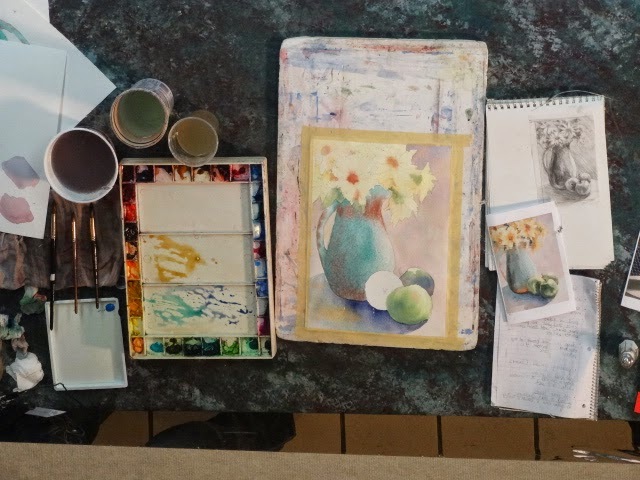
It is the Teacher, but also very much the Performer, that we enjoyed at our GCWS meeting. Susan’s talent and delightful sense of humor was appreciated by all who attended.
Submitted by Joyce Grothaus, Secretary, October 2014

